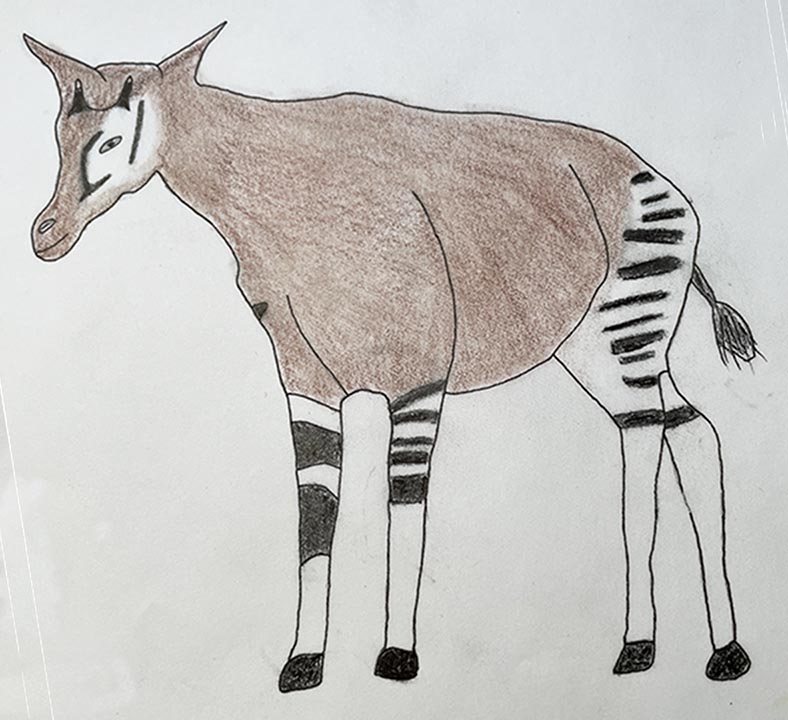They are the tallest mammals today, have an even number of toes, and are geographically limited today to central Africa. Why giraffes have such long necks is still resolved; for example, do the long necks help obtain food more easily, and/or did their long necks evolved to be used for battle against other giraffes? Perhaps, it is for both reasons.
Figure 1: A juvenile giraffe living at the Los Angeles County Zoo. The author took this picture about 30 years ago.
Figure 2: A typical giraffe skull. The dental formula is 0/3, 0/1, 3/3, 3/3 = 32 teeth(see one of my earlier posts that discusses the details of how to determine dental formulae of vertebrates. Note that the upper canine teeth are absent. Also, this skull shows the three unbranched “horns” typically present in both sexes. As shown here, the unique third bone is often found (especially in males) is in front and between the other two horns (Lawlor, 1979).
Determining how many living species there are of giraffes has historically not been an easy task. There has been little or no agreement about this matter, which has been going on over many years now.
Back in the early 1900’s, workers claimed that there is only a single species and nine subspecies. Woolston (2016) did a detailed study of 97% of giraffe’s DNA and determined that there are four species. Subsequent DNA studies by Fennessy et al. (2017) and Coimbra et al (2021) corroborated this number. Nevertheless, in 2023, the number of any possible subspecies ranges continues to be reported by various workers, as from two to four (usually four).
For those who are interested, Pheasant (year not given) has a blog post that agrees that there are four giraffe species. He also included a useful distribution map, showing that most of them live today only in the southern half of Africa [none live in the Sahara region]. They evolved and separated and have not crossbred, thereby there has not been any exchange of genetic material for millions of years. Only about 100,000 giraffes are estimated to be living “in the wild,” and as in the case of other large land mammals, their numbers are dwindling.
Giraffes range in geologic time back as far as about 20 million years ago (i.e., early Miocene). Their long necks first appeared even as early as the Miocene. Even then, they lived in forests. About 8 million years ago, when climate changes caused their eating habits to changes, they started adapting to living in more-open areas.They are most closely related to pronghorns, deer, antelopes, buffalo, goats sheep, and cattle (Wikipedia, 2024).
Classification:
ORDER Artiodactyla
FAMILY Giraffidae
Genus Giraffa
4 Species
giraffa---------------southern giraffe, mainly So. Africa, Namibia, & Botswana
tippelskirchi--------Masai giraffe, in Tanzania, Kenya, and Zambia
reticulata-----------G. cameloparadis, scattered groups in central and eastern Africa
cameloparadalis---G. camelopardalis, in Ethiopa and South Sudan
note: some authors, but not all, recognize “subspecies”
Genus Okapia (has zebra-like stripes on its posterior and legs)
1 Species
johnstoni---limited geographically to central-African rain forests
Figure 3. Okapia johnstoni. This relative of giraffes is about 5 feet tall (at the shoulder) and weights about 440 to 770 pounds. It is mainly active during the day and lives a solitary life in dense forests in the Congo region of central Africa, at 1600 to 4,900 feet in elevation. It eats leaves, fruit, and fungi. The Okapia has an extremely long tongue that can clean its eyes and ears.
Other Comments:
Although nearly all giraffes are reticulated (consisting of connected “spots”), some genetic mutants have a solid brown color (Maron, 2024). Examples like the latter show that relying on color patterns for identifying a species is not always reliable, yet the very similar geometric and color patterns of giraffes are given heavy emphasis for identification as to species.
I have attempted to decipher, via illustrations in the literature, how the so-called different species of giraffes are differentiated by the shapes and sizes of their spots/reticulations. My attempts were frustratingly inconclusive.
REFERENCES CITED
Coimbra, R.T. F. and others. 2021. Whole-genome analysis of giraffe supports four distinct species. Current Biology 31:2929-2938.
Lawlor, T. E. 1979. Handbook to the orders and families of living mammals. Second edition. Mad River Press, Eureka, California, 327 pp.
Pheasant, T. year unknown. The four giraffe species explained. Bonamy (an online blog)
Maron, D.F. 2024. On the coat tales. National Geographic. January, 2024, p. 25.
Wikipedia. 2024
Woolston, C. 1026. DNA reveals that giraffes are four species, not one. Nature 537:290-291.



No comments:
Post a Comment